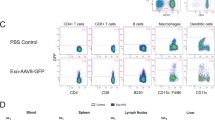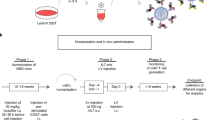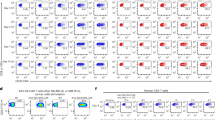Abstract
Human T lymphocytes can be redirected with a new defined specificity by expression of a chimeric T-cell receptor (immunoreceptor) for the use in adoptive immunotherapy of cancer. Whereas standard procedures use retroviral gene transduction to constitutively express immunoreceptors in T cells, we here explored for the first time mRNA electroporation to achieve transient immunoreceptor expression, and thereby minimizing the risk of persistence of potential autoaggression. CD4+ and CD8+ T cells were efficiently transfected with immunoreceptors specific for ErbB2 and CEA. The immunoreceptor expression was transient with half-maximal expression at day 2 and no detectable immunoreceptor expression at day 9 after electroporation. Immunoreceptor-transfected T cells were specifically activated upon coincubation with ErbB2+ and CEA+ tumor cells, respectively, resulting in secretion of interferon-γ (IFNγ), interleukin-2 (IL-2), and tumor necrosis factor-α (TNFα). Furthermore, immunoreceptor-transfected CD8+ T cells specifically lysed ErbB2+ and CEA+ tumor cells, respectively. The RNA-transfected T cells retained their cytotoxic function after 2 days of activation and exhibited cytolytic activities like retrovirally transduced T cells. RNA electroporation of T cells thereby provides a versatile tool for transient immunoreceptor expression, which may be of advantage in avoiding the persistence of unintended autoaggression.
This is a preview of subscription content, access via your institution
Access options
Subscribe to this journal
Receive 12 print issues and online access
$259.00 per year
only $21.58 per issue
Buy this article
- Purchase on Springer Link
- Instant access to full article PDF
Prices may be subject to local taxes which are calculated during checkout





Similar content being viewed by others
References
Restifo NP, Wunderlich JR . Principles of tumor immunity: biology of cellular immune responses. In: DeVita VT, Hellman S, Rosenberg SA (eds). Biologic Therapy of Cancer. Lippincott Co: Philadelphia, 1996, pp 3–21.
Zitvogel L, Tesniere A, Kroemer G . Cancer despite immunosurveillance: immunoselection and immunosubversion. Nat Rev Immunol 2006; 6: 715–727.
Xue S, Gillmore R, Downs A, Tsallios A, Holler A, Gao L et al. Exploiting T cell receptor genes for cancer immunotherapy. Clin Exp Immunol 2005; 139: 167–172.
Bolhuis RL, Willemsen RA, Gratama JW . Clinical applications of redirected cytotoxicity. In: Sitkovsky MV, Henkart PA (eds). Cytotoxic Cells. Lippincott, Williams & Wilkins: Philadelphia, 2000, pp 423–440.
Gattinoni L, Powell Jr DJ, Rosenberg SA, Restifo NP . Adoptive immunotherapy for cancer: building on success. Nat Rev Immunol 2006; 6: 383–393.
Clay TM, Custer MC, Sachs J, Hwu P, Rosenberg SA, Nishimura MI . Efficient transfer of a tumor antigen-reactive TCR to human peripheral blood lymphocytes confers anti-tumor reactivity. J Immunol 1999; 163: 507–513.
Schaft N, Willemsen RA, de Vries J, Lankiewicz B, Essers BW, Gratama JW et al. Peptide fine specificity of anti-glycoprotein 100 CTL is preserved following transfer of engineered TCR alpha beta genes into primary human T lymphocytes. J Immunol 2003; 170: 2186–2194.
Roszkowski JJ, Lyons GE, Kast WM, Yee C, Van Besien K, Nishimura MI . Simultaneous generation of CD8+ and CD4+ melanoma-reactive T cells by retroviral-mediated transfer of a single T-cell receptor. Cancer Res 2005; 65: 1570–1576.
Zhao Y, Zheng Z, Robbins PF, Khong HT, Rosenberg SA, Morgan RA . Primary human lymphocytes transduced with NY-ESO-1 antigen-specific TCR genes recognize and kill diverse human tumor cell lines. J Immunol 2005; 174: 4415–4423.
Leen AM, Rooney CM, Foster AE . Improving T cell therapy for cancer. Annu Rev Immunol 2007; 25: 243–265.
Morgan RA, Dudley ME, Wunderlich JR, Hughes MS, Yang JC, Sherry RM et al. Cancer regression in patients after transfer of genetically engineered lymphocytes. Science 2006; 314: 126–129.
Mendez R, Rodriguez T, Del Campo A, Monge E, Maleno I, Aptsiauri N et al. Characterization of HLA class I altered phenotypes in a panel of human melanoma cell lines. Cancer Immunol Immunother 2008; 57: 719–729.
Seliger B, Maeurer MJ, Ferrone S . Antigen-processing machinery breakdown and tumor growth. Immunol Today 2000; 21: 455–464.
Tao J, Li Y, Liu YQ, Li L, Liu J, Shen X et al. Expression of transporters associated with antigen processing and human leucocyte antigen class I in malignant melanoma and its association with prognostic factors. Br J Dermatol 2008; 158: 88–94.
Eshhar Z . The T-body approach: redirecting T cells with antibody specificity. Handb Exp Pharmacol 2008; 181: 329–342.
Hombach A, Wieczarkowiecz A, Marquardt T, Heuser C, Usai L, Pohl C et al. Tumor-specific T cell activation by recombinant immunoreceptors: CD3 zeta signaling and CD28 costimulation are simultaneously required for efficient IL-2 secretion and can be integrated into one combined CD28/CD3 zeta signaling receptor molecule. J Immunol 2001; 167: 6123–6131.
Heuser C, Hombach A, Losch C, Manista K, Abken H . T-cell activation by recombinant immunoreceptors: impact of the intracellular signalling domain on the stability of receptor expression and antigen-specific activation of grafted T cells. Gene Therapy 2003; 10: 1408–1419.
Hombach A, Heuser C, Abken H . Generation, expression, and monitoring of recombinant immune receptors for use in cellular immunotherapy. Methods Mol Biol 2003; 207: 365–381.
Cheadle EJ, Gilham DE, Hawkins RE . The combination of cyclophosphamide and human T cells genetically engineered to target CD19 can eradicate established B-cell lymphoma. Br J Haematol 2008; 142: 65–68.
Till BG, Jensen MC, Wang J, Chen EY, Wood BL, Greisman HA et al. Adoptive immunotherapy for indolent non-Hodgkin lymphoma and mantle cell lymphoma using genetically modified autologous CD20-specific T cells. Blood 2008; 112: 2261–2271.
Lamers CH, Sleijfer S, Vulto AG, Kruit WH, Kliffen M, Debets R et al. Treatment of metastatic renal cell carcinoma with autologous T-lymphocytes genetically retargeted against carbonic anhydrase IX: first clinical experience. J Clin Oncol 2006; 24: e20–e22.
Bonini C, Grez M, Traversari C, Ciceri F, Marktel S, Ferrari G et al. Safety of retroviral gene marking with a truncated NGF receptor. Nat Med 2003; 9: 367–369.
de Witte MA, Jorritsma A, Swart E, Straathof KC, de Punder K, Haanen JB et al. An inducible caspase 9 safety switch can halt cell therapy-induced autoimmune disease. J Immunol 2008; 180: 6365–6373.
Kieback E, Charo J, Sommermeyer D, Blankenstein T, Uckert W . A safeguard eliminates T cell receptor gene-modified autoreactive T cells after adoptive transfer. Proc Natl Acad Sci USA 2008; 105: 623–628.
Schaft N, Dorrie J, Muller I, Beck V, Baumann S, Schunder T et al. A new way to generate cytolytic tumor-specific T cells: electroporation of RNA coding for a T cell receptor into T lymphocytes. Cancer Immunol Immunother 2006; 55: 1132–1141.
Zhao Y, Zheng Z, Cohen CJ, Gattinoni L, Palmer DC, Restifo NP et al. High-efficiency transfection of primary human and mouse T lymphocytes using RNA electroporation. Mol Ther 2006; 13: 151–159.
Haynes NM, Trapani JA, Teng MW, Jackson JT, Cerruti L, Jane SM et al. Single-chain antigen recognition receptors that costimulate potent rejection of established experimental tumors. Blood 2002; 100: 3155–3163.
Moeller M, Kershaw MH, Cameron R, Westwood JA, Trapani JA, Smyth MJ et al. Sustained antigen-specific antitumor recall response mediated by gene-modified CD4+ T helper-1 and CD8+ T cells. Cancer Res 2007; 67: 11428–11437.
Hombach A, Schlimper C, Sievers E, Frank S, Schild HH, Sauerbruch T et al. A recombinant anti-carcinoembryonic antigen immunoreceptor with combined CD3zeta-CD28 signalling targets T cells from colorectal cancer patients against their tumour cells. Gut 2006; 55: 1156–1164.
Breckpot K, Heirman C, Neyns B, Thielemans K . Exploiting dendritic cells for cancer immunotherapy: genetic modification of dendritic cells. J Gene Med 2004; 6: 1175–1188.
Kyte JA, Gaudernack G . Immuno-gene therapy of cancer with tumour-mRNA transfected dendritic cells. Cancer Immunol Immunother 2006; 55: 1432–1442.
Bonehill A, Tuyaerts S, Van Nuffel AM, Heirman C, Bos TJ, Fostier K et al. Enhancing the T-cell stimulatory capacity of human dendritic cells by co-electroporation with CD40L, CD70 and constitutively active TLR4 encoding mRNA. Mol Ther 2008; 16: 1170–1180.
Dorrie J, Schaft N, Muller I, Wellner V, Schunder T, Hanig J et al. Introduction of functional chimeric E/L-selectin by RNA electroporation to target dendritic cells from blood to lymph nodes. Cancer Immunol Immunother 2008; 57: 467–477.
Hombach A, Koch D, Sircar R, Heuser C, Diehl V, Kruis W et al. A chimeric receptor that selectively targets membrane-bound carcinoembryonic antigen (mCEA) in the presence of soluble CEA. Gene Therapy 1999; 6: 300–304.
Fletcher RH . Carcinoembryonic antigen. Ann Intern Med 1986; 104: 66–73.
Wilkie S, Picco G, Foster J, Davies DM, Julien S, Cooper L et al. Retargeting of human T cells to tumor-associated MUC1: the evolution of a chimeric antigen receptor. J Immunol 2008; 180: 4901–4909.
Hoffmann C, Stellbrink HJ, Dielschneider T, Degen O, Stoehr A, Knechten H et al. Adoptive transfer of syngeneic T cells in HIV-1 discordant twins indicates rapid regulation of T-cell homeostasis. Br J Haematol 2007; 136: 641–648.
Cooper LJ, Ausubel L, Gutierrez M, Stephan S, Shakeley R, Olivares S et al. Manufacturing of gene-modified cytotoxic T lymphocytes for autologous cellular therapy for lymphoma. Cytotherapy 2006; 8: 105–117.
Butterfield LH, Ribas A, Dissette VB, Amarnani SN, Vu HT, Oseguera D et al. Determinant spreading associated with clinical response in dendritic cell-based immunotherapy for malignant melanoma. Clin Cancer Res 2003; 9: 998–1008.
Buckley RH . Gene therapy for SCID—a complication after remarkable progress. Lancet 2002; 360: 1185–1186.
Hacein-Bey-Abina S, Le Deist F, Carlier F, Bouneaud C, Hue C, De Villartay JP et al. Sustained correction of X-linked severe combined immunodeficiency by ex vivo gene therapy. N Engl J Med 2002; 346: 1185–1193.
Newrzela S, Cornils K, Li Z, Baum C, Brugman MH, Hartmann M et al. Resistance of mature T cells to oncogene transformation. Blood 2008; 112: 2278–2286.
Slamon DJ, Godolphin W, Jones LA, Holt JA, Wong SG, Keith DE et al. Studies of the HER-2/neu proto-oncogene in human breast and ovarian cancer. Science 1989; 244: 707–712.
Friedlander E, Barok M, Szollosi J, Vereb G . ErbB-directed immunotherapy: antibodies in current practice and promising new agents. Immunol Lett 2008; 116: 126–140.
Hammarstrom S . The carcinoembryonic antigen (CEA) family: structures, suggested functions and expression in normal and malignant tissues. Semin Cancer Biol 1999; 9: 67–81.
Yamaguchi N, Oyama T, Ito E, Satoh H, Azuma S, Hayashi M et al. NOTCH3 signaling pathway plays crucial roles in the proliferation of ErbB2-negative human breast cancer cells. Cancer Res 2008; 68: 1881–1888.
Acknowledgements
We thank Tanja de Gruijl and Saskia Santegoets (VU University Medical Center, Amsterdam) for providing us with the KATO III cell line, Kris Thielemans (Medical School of the Vrije Universiteit Brussel, Brussels) for providing the pGEM4Z-5′UTR-sig-MAGE-A3-DC.LAMP-3′UTR RNA production vector. We thank Tanja Schunder, Verena Wellner, and Stefanie Baumann for excellent technical assistance. We thank Stefanie Hoyer and Christian Hofmann for fruitful discussions. Work in the Erlangen laboratory was financially supported by the ELAN-Funds of the Friedrich-Alexander-University Erlangen-Nuremberg (DE-07.09.12.1) and the DFG-German Research Foundation (SCHA 1247/1-1). Work in the Cologne laboratory was supported by the European Community through ATTACK and by the Fortune program of the Medical Faculty.
Author information
Authors and Affiliations
Corresponding author
Rights and permissions
About this article
Cite this article
Birkholz, K., Hombach, A., Krug, C. et al. Transfer of mRNA encoding recombinant immunoreceptors reprograms CD4+ and CD8+ T cells for use in the adoptive immunotherapy of cancer. Gene Ther 16, 596–604 (2009). https://doi.org/10.1038/gt.2008.189
Received:
Revised:
Accepted:
Published:
Issue Date:
DOI: https://doi.org/10.1038/gt.2008.189
Keywords
This article is cited by
-
mRNA therapeutics in cancer immunotherapy
Molecular Cancer (2021)
-
CAR-T cell therapy in T-cell malignancies: Is success a low-hanging fruit?
Stem Cell Research & Therapy (2021)
-
Preclinical assessment of transiently TCR redirected T cells for solid tumour immunotherapy
Cancer Immunology, Immunotherapy (2019)
-
mRNA as novel technology for passive immunotherapy
Cellular and Molecular Life Sciences (2019)
-
RNA-transfection of γ/δ T cells with a chimeric antigen receptor or an α/β T-cell receptor: a safer alternative to genetically engineered α/β T cells for the immunotherapy of melanoma
BMC Cancer (2017)



